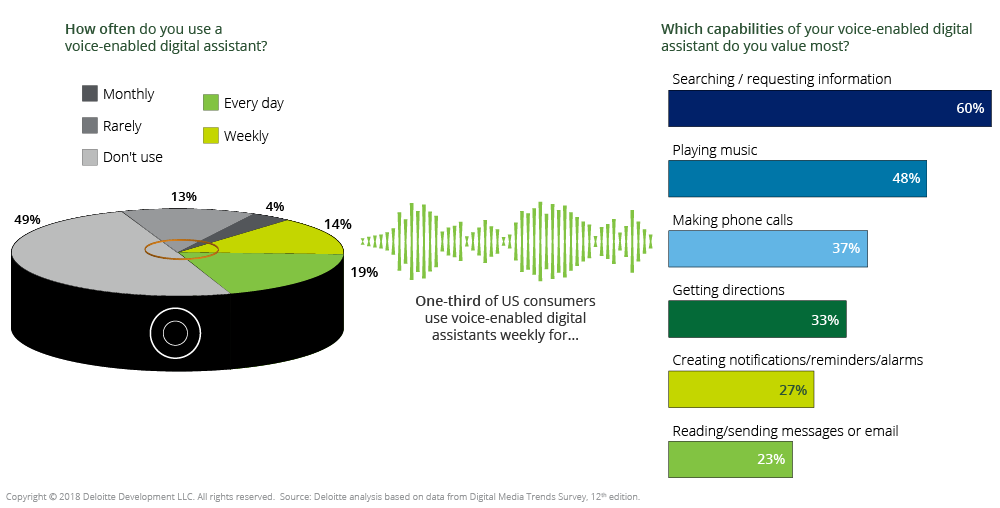CES 2019: Voice assistants speak to consumers has been saved

Perspectives
CES 2019: Voice assistants speak to consumers
How can brands join the conversation?
Voice assistants emerged as one of the biggest trends at the Consumer Electronic Show (CES) 2018.¹ They are expected to repeat the feat in 2019, given voice technology’s growing prominence among US consumers. Deloitte’s 2018 digital media trends (DMT) survey revealed that over half of US consumers use voice assistants (on their mobile device, computer, or via a voice-assisted speaker), and a third use them weekly.²
Explore content
- November 14, 2018
- Deloitte at CES® 2019: Smart future
- Digital media trends survey
- 2018 global mobile consumer survey: US edition
- Get in touch
Figure 1: Consumers currently prefer using voice assistants for simpler tasks

Source: Deloitte analysis based on data from Digital media trends survey, 12th edition
Our analysis showed that consumers are using voice assistants primarily as a remote control for simpler capabilities such as searching or requesting information, playing music, and making phone calls. While the smartphone remains the most popular platform for voice-assistant usage3, other form factors are gaining traction as well. According to Deloitte’s Global mobile consumer survey, penetration of voice-assisted speakers nearly doubled from 12 percent in 2017 to 20 percent in 2018.4 Some experts believe that voice could become the next big thing in human-computer interaction, after touch.5
By far, consumers’ most valued voice-assistant use case is searching for or requesting information.6 Hence, voice assistants present a major opportunity for search-based advertising. Research shows that worldwide search ad spending on voice assistants is expected to reach nearly $19 billion by 2022, representing the largest revenue opportunity for the technology.7 Another study shows that by 2020, around 50 percent of all consumer search queries will be voice-based.8
What does this shift mean for brands and advertisers?
Brands will likely have to incorporate voice-based search optimization (in addition to text-based search) to effectively address voice queries. Unlike text, voice searches comprise conversational keywords. Companies will thus have to use advanced natural language processing techniques to mimic human language for voice-based searches. It is therefore not surprising that a significant number of advertising professionals cited voice search as a challenge that will impact their businesses in 2018.9
“With voice assistance becoming the user interface (UI) of choice for consumers, advertisers now have the ability to deliver highly targeted personalized messages to consumers in real time,” explained Sharon Harris, vice president, Ecosystems & Alliances, Deloitte Consulting LLP. “Voice assistance puts a greater focus on consumer intent and highlights how ML [machine learning] and AI [artificial intelligence] could be enhanced for predictive modeling across other platforms.” Playing music is the second-most-valued use case for voice assistants—creating an opportunity for music streaming services. Around 33 million US households subscribe to a paid music streaming service, and the number is expected to grow further.10 According to the RIAA, music streaming services accounted for 65 percent of US recorded-music revenues in 2017.11
Interestingly, DMT survey data shows that penetration of music streaming services is much higher (1.7x) for people who use voice assistants on a weekly basis.12 Thus, voice-assistant providers with a music streaming offering have an inherent advantage when it comes to targeting/acquiring consumers. However, other music streaming players can enter the voice-assistant space, too, through development or partnerships.13
Searching information and playing music have emerged as the top two ways in which consumers interact with voice assistants. This has tilted the balance in favor of those who capitalize on these opportunities first.14 Brands and marketers who understand voice-search nuances are probably best-positioned to help users find what they’re looking for. Likewise, music streaming providers with a voice-assistant offering can leverage it to add more users.15 Nonetheless, it’s still “early days” for voice technology. Companies in the ecosystem should continue adapting their offerings based on popular use cases, while also experimenting with new ones. Who knows? One of them might turn out to be the next “killer app.”
This charticle authored by Shashank Srivastava on November 14, 2018.
Deloitte at CES® 2019: Smart future
January 8-11, 2019 | Las Vegas, NV
What’s the next big thing in “smart”—and what should you do about it? Join Deloitte at CES starting with pre-conference sessions on January 7, 2019, for a visionary—and practical—look at all things smart: mobility, connectivity, the enterprise, cities, and entertainment. Explore how emerging technologies are blurring traditional industry lines, impacting people and organizations, and enabling a smart future.
Learn more about Deloitte's presence at CES® 2019

Digital media trends survey
A new world of choice for digital consumers
Digital media consumers across generations are increasingly in the driver’s seat—and their expectations are at an all-time high. Some major shifts are now occurring. What are the implications for technology, media, and telecommunications companies?

2018 global mobile consumer survey: US edition
A new era in mobile continues
Once again, smartphones are at the center of the connected universe. Our survey revealed that consumer habits—from smartphone and smartwatch adoption and increased use of digital voice assistants to demand

Endnotes
1 Bret Kinsella, “CES 2018 Voice Assistant Roundup—A Big Year Indeed,” Voicebot, January 15, 2018.
2 Deloitte analysis based on data from Deloitte’s Digital media trends survey, 12th edition.
3 Deloitte, Global mobile consumer survey 2018, US edition.
4 Ibid.
5 Eric Bieller, “What’s the Future of Human-Computer Interaction (HCI)?,” CareerFoundry, September 20, 2018; Anthony Miller, “Voice Interfaces: New Era of Human-Computer Interactions,” millermedia7, August 15, 2017.
6 Deloitte, Digital media trends survey, 12th edition.
7 Sarah Perez, “Voice-enabled Smart Speakers to Reach 55% of US Households by 2022, Says Report,” TechCrunch, November 21, 2018.
8 Christi Olson, “Just Say It: The Future of Search Is Voice and Personal Digital Assistants,” Campaign, April 25, 2016.
9 Ibid.
10 Kevin Westcott, Jeff Loucks, Shashank Srivastava, David Ciampa, “Digital media segments: Looking beyond generations,” Deloitte Insights, October 5, 2018.
11 Cherie Hu, “Paid Music Streaming Subscribers Surpass 50 Million in US, but There's a Twist,” Billboard, September 11, 2018.
12 Ibid.
13 Stuart Dredge, “What Do Smart Speakers and Voice Assistants REALLY Mean for Music?,” Music Ally, January 23, 2018.
14 Bernard May, “Five Ways Voice Technology Is Transforming Our Lives And Businesses,” Forbes, June 6, 2018.
15 David Sidebottom, “Smart Speakers Drive Music Consumption,” Audio Xpress, March 23, 2018.
Recommendations
CES 2019: Voice assistants speak to consumers
How can brands join the conversation?



